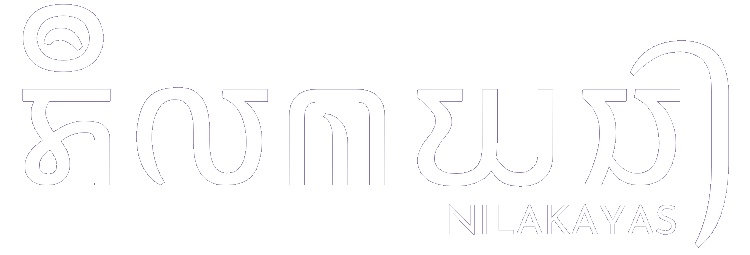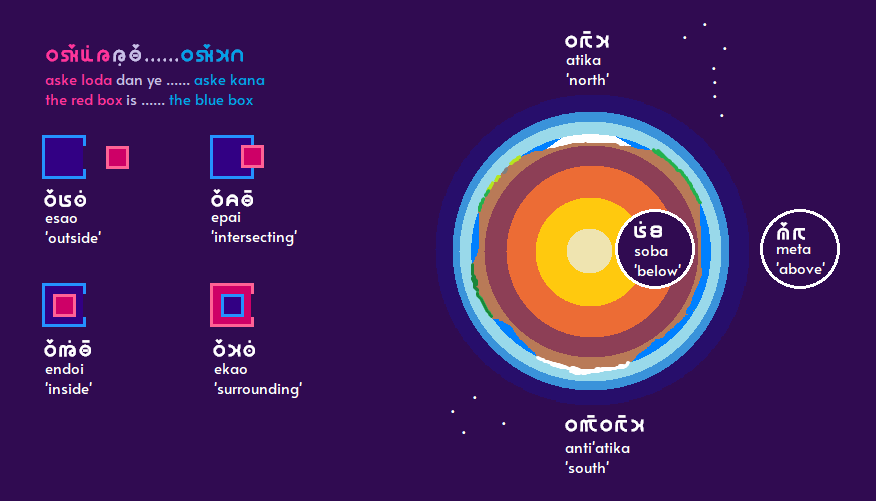 ☰
☰
This is the page for Lingowa Gona grammar. Also see phonology, dictionary, word derivation, or go back to the main lingowa gona page
We use the gnomic copula "to" (tu) to make simple statements about identity or physical description. This type of sentence has the following structure: [subject] TO [noun/adjective].
kituIma
ki to ima
I am a human
nilitawutumegawu
ni litao to megao
this rock is big
If the subject is indefinite (not a specific individual), this sentence will be understood as a general statement about what is expected to be always or at least typically true for every individual of that category.
talasawutukana
talasao to kana
(all) oceans are typically blue
(if I know that A is an ocean, I can safely assume that A is blue)
InliginatuInkula
inligina to inkola
a tree is always a plant / (all) trees are always plants
(if A is a tree, then by definition A is also a plant)
Usually these are actions that people do by themselves, mostly without affecting others. This type of sentence has the following structure: [subject] [verb].
pisesaminikulmass
pisesa mini kolmas
A small fish is swimming
kimentemm
ki mentem
I am thinking/imagining
Usually these are actions that people do to other things. They directly affect the object of their action. This 'direct object' is marked by the accusative "si" (si). This type of sentence can have different structures based on convenience because putting things at the end allows you to add a relative clause to give more information about it.
1. [verb] [subject/actor] SI [object/patient] -> emp. on object (most common)
2. [subject/actor] SI [object/patient] [verb] -> emp. on verb
3. SI [object/patient] [verb] [subject/actor] -> emp. on subject
pagusskisiakuwa
pagos ki si'akowa
I drink some water
kisiakuwapaguss
ki si'akowa pagos
I drink some water
siakuwapagusski
si'akowa pagos ki
I drink some water
pudesslasiki
podes la si'ki
She causes/commands me to walk
Cognitive verbs are typically intransitive. It's something you experience mostly without directly affecting others. Sometimes, it has a theme: a thing whose idea or concept of it is involved in that thought. This 'theme' is marked by the pertinential "tan" (tann). This type of sentence has the following structure: [subject/experiencer] [verb] TAN [theme].
kimentemmtannImpaguss
ki mentem tan'impagos
I am thinking of food
laakustimmtannAwiya
la akostim tan'awiya
She hears (the sound of) a bird
lalayudammtannnipumawukukusu
lala yodam tan'ni pomao kokoso
They are happy/pleased about this coconut
This preposition can also be used as a complementizer.
kiUlammtannnitetuneginiss
ki olam tan ni tetone ginis
I saw that this house caught on fire
lapunusstannpanaInabiyuss
la ponos tan pana ina biyos
He said that everyone is alive
Noun phrases are typically head-initial, that means you put adjectives after the noun.
tetunemegawu
tetone megao
a big building
If you put two nouns next to each other, like this: [noun 1] [noun 2], that means it's a [noun 1] that is typically associated with [noun 2].
pasmayineya
pasmai neya
baby clothes (a type of clothes made for babies, not necesserily clothes that are owned by a particular baby)
Posessions are marked by the word "ya" (ya) in this structure: [noun] YA [owner]. This indicates a degree of control over something, e.g. rights to use an object and autonomy over one's body.
pasmayiyaki
pasmai ya ki
clothes which are owned by me
You can make relative clauses using the word "pa" (pa).
Imapasipisesapalmuss
ima pa si'pisesa palmos
the person who caught a fish
pisesapapalmussIma
pisesa pa palmos ima
the fish that a person caught
ImapaUlammtannnesiya
ima pa olam tan'nesiya
the person who saw an island
nesiyapaInaUlamm
nesiya pa ina olam
the island that a person saw
However, numbers and demonstratives goes before the noun.
nayilituyi
nai litoi
not a rock (something which is not a rock, a non-rock)
nilalituyi
nila litoi
zero rocks (no rocks, doesn't imply that something else is there)
duwalituyi
dowa litoi
two rocks
nilituyi
ni litoi
this rock (this thing which is a rock)
niduwalituyi
ni dowa litoi
these two rocks (these things which are two rocks, there are two in total)
duwanilituyi
dowa ni litoi
two of these rocks (there are several rocks, but I only want two)
alulituyi
alo litoi
the other rock (not this one, the other thing that is also a rock)
aluduwalituyi
alo dowa litoi
the other two rocks (there are two rocks aside from this one)
duwaalulituyi
dowa alo litoi
two additional rocks (there are many other rocks aside from this one, we take two of them)
You can make a negative statement using the word "nai" (nayi). It negates the word after it, like this: NAI [word] which means 'not [word]'.
nitunayipisesayi
ni to nai pisesai
This is not a stingray
nayibatesskisipu
nai bates ki si'po
I did not hit you
Open-ended questions are made by putting the word "we" (we) in the place of the missing information.
nituwe
ni to we?
What is this?
pagusspusiwe
pagos po si'we?
What did you eat?
You can also limit the amount of possible answers that you want to receive.
pagusspusiwepadellpisesawatawalawu
pagos po si'we pa del pisesa wa tawalao?
Out of the following: fish and cattle, what did you eat? / Did you eat fish or beef?
Yes-no or closed questions are made using the word "wedantan" (wedantann) in front of the sentence.
wedantannpagusspusipumuyi
wedantan pagos po si'pomoi?
Is it true that you ate a fruit? / What is true about (the statement that) you ate a fruit?
If every part of the statement is correct, you can answer with "panadan" (panadann). If there are some mistakes, you can answer "nai panadan" (nayipanadann) and give your own statement to correct it. If every part of the statement is false, you can answer with "niladan" (niladann).
There are four spatial prepositions that indicate thing’s relationship to a place:
You can add spatial nouns after a preposition to further specify its location: [preposition] [spatial noun] [place/location]. Some spatial nouns are oriented to the thing itself; some are oriented to the speaker/observer (left, right, front, back); and some are oriented to Earth.


The locative "ye" (ye) can also function as a relativizer.
kikinesskayetenikasspediyasilituyi
ki kines ka ye tenikas pediya si'litoi
I went to the place where the children were playing with rocks
Words that indicate time are in the form of adverbs and they usually have the suffix “-kal” (kall), for example: “nokakal” (nukakall, at night) and "lomakal" (lumakall, at noon). These words can be placed at the begining or at the end of the sentence. Other concepts, such as duration, beginning, and end are expressed using the spatial prepositions: the vialis “diya” (diya), the ablative “del" (dell), and the lative “ka” (ka) respectively.
nukakalllapudess
nokakal la podes
She walks at night
lapudessdelllumakall
la podes del lomakal
She has been walking since noon
You can also use "kal" as a relativizer.
palmusskisiniawiyakalllanayikulmass
palmos ki si'ni awiya kal la nai kolmas
I caught this bird when it was not flying
You can indicate that an action is finished or completed by adding the prefix "poste" (puste) to the verb. And you can indicate that an action has not started yet by adding the prefix "ante" (ante)
pusteImbesskisiakuwakaInkula
poste'imbes ki si'akowa ka Inkola
I have finished spraying water onto the plants
lumaneyakallkiAntedumemm
lomaneyakal ki antedomem
I have not fallen asleep yet when the morning comes
You can use "poste" and "ante" inside a temporal clause to express events that happen before or after another event.
ImbesskisiakuwakakikalkipusteAnestimm
imbes ki si'akowa ka ki kal ki poste'anestim
I shower myself with water when I have woken up / I take a shower after I wake up
Numbers are placed before the thing they measure, like this: [number] [noun/verb/units]. For nouns, they describe the amount of things. For verbs, they describe the number of repetition.
latiyapunusstannni
la tiya ponos tan'ni
He said it three times
pentasimiyadannyemetaInliginu
penta simiya dan ye meta inligino
There are five monkeys above the tree
niInliginuImetatetametellll
ni inligino to imeta teta meter
This tree is four meters high
Comparatives have set phrases. The positive phrase "more [characteristic] than something" is expressed with the construction: IPEN [characteristic] POSTE [reference] (Ipenn...puste...). Meanwhile, the negative phrase "less [characteristic] than something" is expressed with the construction: IPON [opposite characteristic] ANTE [reference] (Ipunn...ante...).
InliginatuIpennImetapusteki
inligina to ipen imeta poste ki
A tree is tall-er than me / A tree is more tall superior to me
kituIpunnInsubaAnteInligina
ki to ipon insoba ante inligina
I am short-er than a tree / I am less short inferior to a tree
kituIsuImetawapu
ki to iso imeta wa po
I am just as tall as you
In complex comparatives, word order and the placement of reference can help disambiguate which element is being compared.
pagusskisipisesapaIpennpuleyipustetawalawu
pagos ki si'pisesa pa ipen polei poste tawalao
I eat more fish than (I eat) cattle (beef)
(compares the amount of fish that I eat with the amount of cattle that I eat)
sipisesapaIpennpuleyipagusskipustetawalawu
si'pisesa pa ipen polei pagos ki poste tawalao
I eat more fish than a cattle (eats fish)
(compares the amount of fish that I eat with the amount of fish that a particular cattle eats)
Previously, the gnomic "to" (tu) was used in nominal sentences, but it can also be used in verbal sentences to make aphorisms, statements about the general truth or what is typically true.
pisesatubiyussyetalasawu
pisesa to biyos ye talasao
Fishes (typically) live in the sea
(I'm not talking about some particular fish that is alive and exists in the sea. I'm saying that fishes can survive in the sea since it's their natural habitat)
lalatuyudammtannpumawukukusu
lala to yodam tan'pomao kokoso
They (typically) like coconuts
(I'm not talking about that one time when they enjoy a particular coconut. I'm saying that coconuts suit their preferences)
You can also use the gnomic with a temporal clause to make a conditional sentence..
putunayidumemmkallpustepagusspusiakuwakapeya
po to nai domem kal postepagos po si'akowa kapeya
You would not fall asleep if you had drunk coffee
The imperative "so" (su) can be placed before a verb to indicate suggestions, requests, commands, obligations, and needs. It means, "Do this, or else something bad will happen". You can differatiate based on urgency: low ("ipo", Ipu), medium ("mesa", mesa), or high ("ipe", Ipe).
supagusspusiakuwa
so pagos po si'akowa
You should drink some water. (urgency is unspecified)
Ipesupagusspusiakuwa
ipe so pagos po si'akowa
You should really drink some water. (high urgency, e.g. dehydration)
There are also variations to indicate negative imperative "sonai" (sunayi), the lack of any imperative "sowa" (suwa), and conflicting imperative "sowanai" (suwanayi)
pusunayikulmassyeni
po sonai kolmas ye ni
You shouldn't swim here. (something bad will happen if you swim here)
pusuwakulmassyeni
po sowa kolmas ye ni
You are free to or to not swim here. (either way is good)
pusuwanayikulmassyeni
po sowanai kolmas ye ni
You are damned if you swim and damned if you don't swim here. (neither is good)